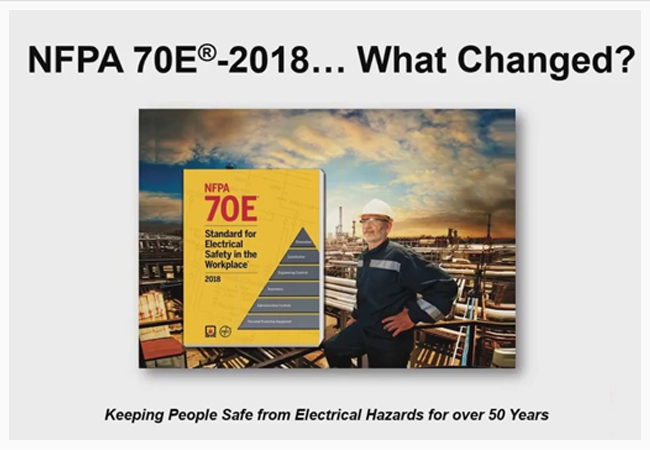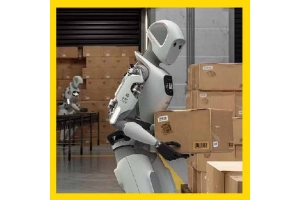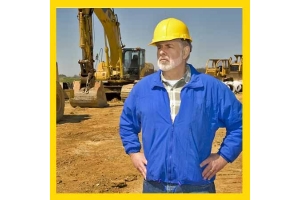Currency
March 27, 2018

If there’s a workplace fatality, or if injury/illness rates are too high, or workplace hazards and risks are perceived to be great, employers, disgruntled workers and outside interested parties, such as OSHA, often seek an EHS revolution -- rapid fundamental change.
But frequent slip-backs to that past unwanted state are common. The best way to affect change is by gradual and continuous improvement.
These two definitions for “shock hazard” demonstrate evolving EHS improvement:
** Shock hazard is a dangerous condition associated with the possible release of energy caused by contact or approach to energized electrical conductors or circuit parts.
** Shock hazard is a source of possible injury or damage to health associated with current through the body caused by contact or approach to an energized electrical conductors or circuit parts.

Definition A is found in the 2015 edition of NFPA® 70E® Standard for Electrical Safety in the Workplace. Definition B is found in 70E® 2018. You want to train employees using definition B.
70E® first appeared in 1979 and is updated about every three years. You had to think like an electrician to appreciate 70E® in its early days. Users of 70E® 2018 must think like a global professional.
70E® 2018 requires employers to integrate an electrical safety program into a management system, such as ANSI Z10, when one exists, apply risk assessments, understand risk management (ISO 31000 is presented in the standard), and use hierarchy of controls. Elimination of electrical hazards must now come first.
Replacing “accident” with “incident” and “accidental” with “unintentional” are examples how 70E® 2018 has evolved to harmonize with international terms. “Damage” to health, as noted in definition B above, is an international term. Applying 70E® 2018 evolves EHS language.
Rapid fundamental change for electrical hazards using the full scope of 70E® 2018 may shock you. Included in the electrical safety program are practices such as inspecting electrical equipment, planning every job, reducing risk through hierarchy of controls, and auditing the program. OSHA doesn’t require an employer to conform to these practices and OSHA doesn’t require employers to implement a management system. But consensus standards, such as 70E®, may be used by OSHA to assist with regulatory compliance; particularly if something bad happens.
Employers are required to implement their electrical safety program into an occupational safety and health management system, when one exists. Is a management system important?
Good customers often prefer to work with good suppliers. Years back, major automotive manufacturers required tier-one suppliers to certify to ISO 14001, environmental management system. According to Wikipedia, as of 2017, more than 300,000 certifications to ISO 14001 can be found in 171 countries. Like ISO 14001, customers may require key suppliers to certify to the forthcoming ISO 45001 occupational safety and health management standard. My guess is that ISO 45001 certifications will surpass the number of ISO 14001 certifications.
70E® generally gives users a head-ups for future requirements. 70E® 2018 contains an Informative (not required) Annex Q Human Performance and Workplace Electrical Safety.
Annex Q provides extensive behavioral safety information. Rule-based, knowledge-based, and skill-based modes of human behavior and associated errors are reviewed. Explanation of human performance tools include: pre-job briefing; job site review; post job review; procedure use and adherence; self-check with verbalization; three-way communication; seven steps when unsure; and, flagging and blocking. Human performance warning flags address: program or process; organizational performance; supervisor performance; worker performance; workplace culture; supervisors and managers; and, the organization.
Informative Annex Q hints that employers should gradually implement a human performance program to complement their electrical safety program before it becomes a requirement for 70E® 2021, assuming the three-year update remains on track.
American National Standard for Industrial Robots and Robot Systems – Safety Requirements (ANSI/RIA R15.06-2012) is another consensus standard that includes requirements for electrical safety. ANSI’s 2012 robotic safety standard preceded 70E® to require employers to implement concepts such as hazard identification, risk assessment and hierarchy of controls. ANSI/RIA 15.06 requires, for example, that robotic risks be eliminated first by design or by substitution, then by safeguarding. Residual risks shall be reduced by other measures such as warnings, signs, and training.
Like 70E®, ANSI’s robotic safety standard expands associated hazards that must be recognized, evaluated and controlled. For example, the ANSI/RIA R15.06 list of “significant hazards” includes noise, vibration, radiation, chemicals, and ergonomics (potential consequences include human fatigue and mental stress).
As you see, narrow views are being supplanted with big-picture controls. Examples just provided include risk assessment, hierarchy of controls, human performance, etc. all blended into a management system.
Instead of rapid fundamental change, EHS evolution requires planning and an implementation strategy. To be sure, sometimes rapid change is sometimes necessary when bad things happen. Full conformance to consensus standards for safety such as 70E® may be thrust upon an employer. Regarding 70E® 2018, you should explain the standard, including a summary of informative annexes, to management and affected parties, such as electricians. Welcome a debate on 70E®’s broad implications. The objective is to obtain agreement that some elements of the standard (not already required by OSHA) should be implemented to gradually improve electrical safety performance.
Occupational safety and health continues to evolve and improve. Pros must endeavor to help others evolve to understand the broad efforts necessary to prevent worker injury and illness.
But frequent slip-backs to that past unwanted state are common. The best way to affect change is by gradual and continuous improvement.
An evolution
These two definitions for “shock hazard” demonstrate evolving EHS improvement:
** Shock hazard is a dangerous condition associated with the possible release of energy caused by contact or approach to energized electrical conductors or circuit parts.
** Shock hazard is a source of possible injury or damage to health associated with current through the body caused by contact or approach to an energized electrical conductors or circuit parts.

Definition A is found in the 2015 edition of NFPA® 70E® Standard for Electrical Safety in the Workplace. Definition B is found in 70E® 2018. You want to train employees using definition B.
70E® first appeared in 1979 and is updated about every three years. You had to think like an electrician to appreciate 70E® in its early days. Users of 70E® 2018 must think like a global professional.
70E® 2018 requires employers to integrate an electrical safety program into a management system, such as ANSI Z10, when one exists, apply risk assessments, understand risk management (ISO 31000 is presented in the standard), and use hierarchy of controls. Elimination of electrical hazards must now come first.
Replacing “accident” with “incident” and “accidental” with “unintentional” are examples how 70E® 2018 has evolved to harmonize with international terms. “Damage” to health, as noted in definition B above, is an international term. Applying 70E® 2018 evolves EHS language.
NFPA® 70E® requirements
Rapid fundamental change for electrical hazards using the full scope of 70E® 2018 may shock you. Included in the electrical safety program are practices such as inspecting electrical equipment, planning every job, reducing risk through hierarchy of controls, and auditing the program. OSHA doesn’t require an employer to conform to these practices and OSHA doesn’t require employers to implement a management system. But consensus standards, such as 70E®, may be used by OSHA to assist with regulatory compliance; particularly if something bad happens.
Employers are required to implement their electrical safety program into an occupational safety and health management system, when one exists. Is a management system important?
Good customers often prefer to work with good suppliers. Years back, major automotive manufacturers required tier-one suppliers to certify to ISO 14001, environmental management system. According to Wikipedia, as of 2017, more than 300,000 certifications to ISO 14001 can be found in 171 countries. Like ISO 14001, customers may require key suppliers to certify to the forthcoming ISO 45001 occupational safety and health management standard. My guess is that ISO 45001 certifications will surpass the number of ISO 14001 certifications.
What’s coming next?
70E® generally gives users a head-ups for future requirements. 70E® 2018 contains an Informative (not required) Annex Q Human Performance and Workplace Electrical Safety.
Annex Q provides extensive behavioral safety information. Rule-based, knowledge-based, and skill-based modes of human behavior and associated errors are reviewed. Explanation of human performance tools include: pre-job briefing; job site review; post job review; procedure use and adherence; self-check with verbalization; three-way communication; seven steps when unsure; and, flagging and blocking. Human performance warning flags address: program or process; organizational performance; supervisor performance; worker performance; workplace culture; supervisors and managers; and, the organization.
Informative Annex Q hints that employers should gradually implement a human performance program to complement their electrical safety program before it becomes a requirement for 70E® 2021, assuming the three-year update remains on track.
Robots and electrical hazards
American National Standard for Industrial Robots and Robot Systems – Safety Requirements (ANSI/RIA R15.06-2012) is another consensus standard that includes requirements for electrical safety. ANSI’s 2012 robotic safety standard preceded 70E® to require employers to implement concepts such as hazard identification, risk assessment and hierarchy of controls. ANSI/RIA 15.06 requires, for example, that robotic risks be eliminated first by design or by substitution, then by safeguarding. Residual risks shall be reduced by other measures such as warnings, signs, and training.
Like 70E®, ANSI’s robotic safety standard expands associated hazards that must be recognized, evaluated and controlled. For example, the ANSI/RIA R15.06 list of “significant hazards” includes noise, vibration, radiation, chemicals, and ergonomics (potential consequences include human fatigue and mental stress).
What’s your strategy?
As you see, narrow views are being supplanted with big-picture controls. Examples just provided include risk assessment, hierarchy of controls, human performance, etc. all blended into a management system.
Instead of rapid fundamental change, EHS evolution requires planning and an implementation strategy. To be sure, sometimes rapid change is sometimes necessary when bad things happen. Full conformance to consensus standards for safety such as 70E® may be thrust upon an employer. Regarding 70E® 2018, you should explain the standard, including a summary of informative annexes, to management and affected parties, such as electricians. Welcome a debate on 70E®’s broad implications. The objective is to obtain agreement that some elements of the standard (not already required by OSHA) should be implemented to gradually improve electrical safety performance.
Occupational safety and health continues to evolve and improve. Pros must endeavor to help others evolve to understand the broad efforts necessary to prevent worker injury and illness.









